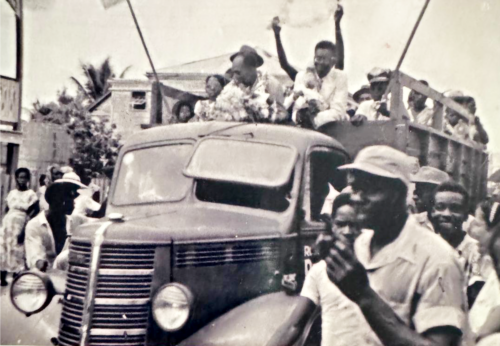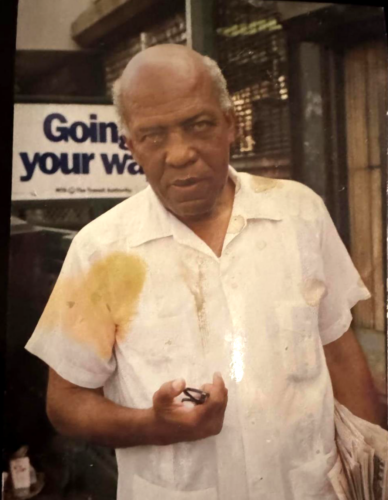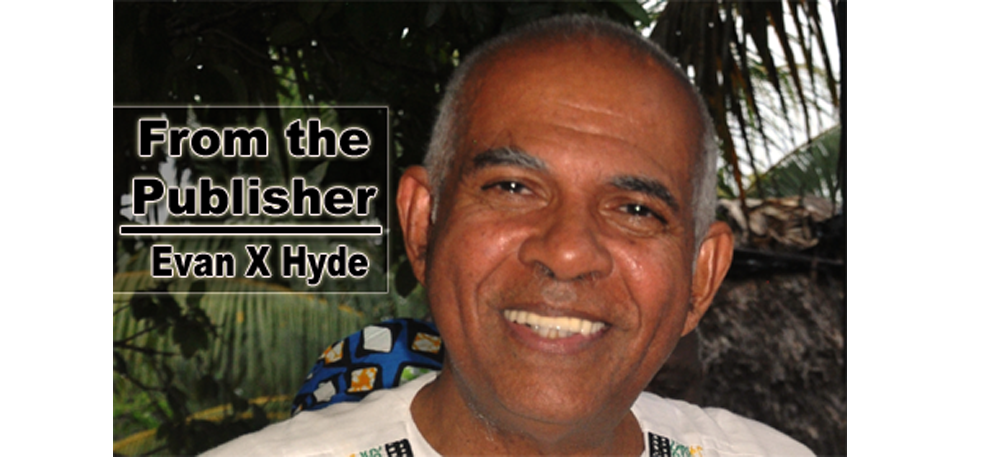
I believe the photograph of the truck and celebration seen here was taken when PUP leaders, Leigh Richardson and Philip Goldson were released from the old Her Majesty’s Prison after serving nine months (of hard labor) of a one-year sentence (“back-a-Baptist”). Richardson and Goldson were charged with sedition by the British colonial government of the time, and convicted in the Supreme Court of British Honduras because of words in a newspaper article which the powerful British considered provocative. They were convicted in 1951, but I’m not sure whether they were released in late 1951 or early 1952.

Leigh Richardson
The single gentleman in the other photograph is Leigh Richardson. I assume it was taken by the late David Jenkins when Mr. Richardson visited Belize late in his life. He had been living in New York City.
The PUP leader when Richardson and Goldson were jailed was Johnny Smith. Heeding the warning from the British, Smith resigned from his PUP leadership post and went into exile in the United States.
Leigh Richardson became PUP leader around 1953, I would say, and therefore would have led the anti-colonial party to the historic national election victory of 1954, the first held under universal adult suffrage in Belize, and one in which the PUP won 8 out of 9 seats nationwide. The PUP was opposed in that election by the National Party, a pro-British group.
It was always intriguing to me that Richardson was PUP leader while the local mahogany and chicle magnate, Robert Sydney Turton, was still alive and kicking. It was Mr. Turton who had pushed his personal secretary, George Price, into local politics in the mid-1940s. But it was the year after Mr. Turton died in 1955 that Mr. Price ousted Richardson as PUP leader.
A couple years before my father died, I asked him if Mr. Richardson had been supported by Mr. Turton, and he said yes, that Mr. Richardson basically accepted instructions and advice from Mr. Turton.
When Mr. Price overthrew Richardson and Goldson as PUP leaders in 1956 — as people like Don Hector Silva, who is the only one still alive from that era of politics, will tell you — the basic dispute within the PUP was about a so-called West Indian Federation being proposed by the British, which Price and his supporters rejected, but with which Richardson and Goldson may have been comfortable.
The fact of the matter is that the Roman Catholic Church in Belize clearly became more influential with Mr. Price, a former Catholic seminarian who went to Mass every morning, as Leader.
The year after their ouster from the PUP, Richardson and Goldson formed the Honduran Independence Party (HIP), but the HIP performed very poorly in the national election in 1957, and soon after that election Mr. Richardson quietly migrated to Trinidad, where he worked as a journalist for a newspaper there for many years before moving to New York City. It appears to me that it was only late in his life that he finally visited Belize again, when this photo would have been taken by the late Mr. Jenkins.
Mr. Richardson had a half-brother by the name of Edgar Richardson, who became an officer of UBAD a few weeks after the organization was formed in early 1969. Edgar X (now deceased) was a very, very popular speaker on the UBAD rostrum, but his affiliation with the organization had a negative effect on his marriage, broke it up, in fact, and he left Belize in September of 1969 to live in Los Angeles. While there, he was active in the BREDAA movement after Ismail Shabazz, the former UBAD secretary/treasurer, migrated to L.A. in the mid/late 1970s.
Leigh Richardson was more of a tough guy, so to speak, than Mr. Goldson. Mr. Goldson ended up with The Belize Billboard, which had been the PUP newspaper, and after Richardson migrated to Trinidad, Mr. Goldson took the HIP into a coalition with the National Party to form the National Independence Party (NIP).
But Mr. Goldson dedicated most of his time to the newspaper during the late 1950s, it appears to me, and in fact he did not even run as a candidate for the NIP in the 1961 general election, the first Ministerial election in the history of British Honduras.
When I say Leigh was more of a tough guy than Philip, I mean physically, because Mr. Goldson fought some heroic, courageous battles in his public life after Mr. Richardson abandoned Belize for decades. The talking has always been that Leigh pulled out a gun when the pro-Price faction ran him out of Riverside Hall on the night of his overthrow as PUP leader. But the details of the 1956 coup have never been properly documented. Granted, the media here was relatively tiny in those days. There was no television, one British-controlled radio station, and The Billboard.
The former editor of this newspaper, Russell Vellos, has said that he believes the truck photo was taken on Regent Street West near his mother’s family home. I think that is the case. The photo is historic, and I thought it should be reproduced for the benefit of our younger generations. Hence, the column.

